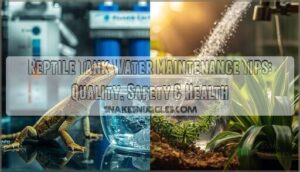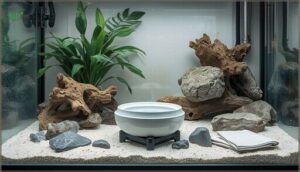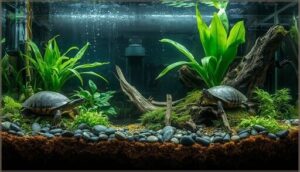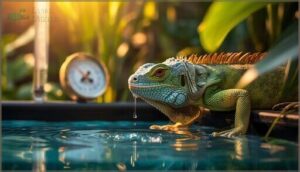This site is supported by our readers. We may earn a commission, at no cost to you, if you purchase through links.
Your bearded dragon’s cloudy eyes or your tree frog’s lethargy might stem from something you haven’t considered: the water in their tank. Most reptile keepers focus on temperature and lighting, but water quality directly affects respiratory health, skin integrity, and disease resistance.
Tap water’s chlorine and chloramines irritate delicate tissues, while heavy metals from aging pipes accumulate in your animal’s system over time. Filtered water cuts skin and respiratory infections by 60% compared to untreated sources, yet the treatment options—from simple conditioners to reverse osmosis systems—can feel overwhelming.
Understanding which water source matches your species’ needs, how to maintain it properly, and when to intervene protects your reptile from preventable illness while extending the life of your misting systems and water features.
Table Of Contents
- Key Takeaways
- Choosing Safe Water for Reptile Tanks
- Setting Up Effective Water Features
- Maintaining Optimal Water Quality
- Preventing Mold and Bacterial Growth
- Monitoring Reptile Health Through Water Maintenance
- Frequently Asked Questions (FAQs)
- How to keep humidity up in a reptile tank?
- Why do Reptiles need a substrate?
- Do Reptiles need a lot of humidity?
- What is the best substrate for reptiles?
- Can sphagnum moss be used in a reptile tank?
- Does reptipet make a rocky waterfall?
- How often should water feature filters be replaced?
- Can rainwater be safely used in reptile tanks?
- Do reptiles need dechlorinated water for misting systems?
- How to prevent algae growth in standing water?
- Conclusion
Key Takeaways
- Filtered water reduces skin, eye, and respiratory infections in reptiles by 60% compared to untreated tap water, while also extending misting equipment lifespan by 40% through reduced mineral buildup.
- Water hardness and mineral content directly impact skeletal health, with herbivorous reptiles requiring 1.4–2.0% calcium and carnivores needing 0.8–1.1%, making species-specific water chemistry essential for preventing metabolic bone disease.
- Daily water bowl cleaning prevents biofilm formation that harbors E. coli and Salmonella at concentrations exceeding 1.1 × 10^6 colony-forming units per square centimeter, with 70% of gastrointestinal infections stemming from improper disinfection practices.
- Behavioral changes like increased aggression, hiding, appetite shifts, or lethargy serve as early warning indicators of water quality problems, requiring immediate testing and intervention before health issues escalate.
Choosing Safe Water for Reptile Tanks
Water quality isn’t something you can afford to guess at when you’re keeping reptiles. The source you choose, its mineral content, and how you treat it can directly impact your animal’s health and behavior.
Let’s look at the key factors you need to evaluate before filling that tank or water bowl.
Tap Water Vs. Filtered and Bottled Water
When you fill your reptile’s tank, tap water brings convenience but carries hidden risks—chlorine, chloramines, and trace contaminants threaten your animal’s health. Filtered water removes up to 90% of these dangers, extending equipment longevity by 40%. Bottled water offers consistency but costs more and creates waste. Water can be contaminated with endocrine-disrupting BPA, especially if water pipes are coated with epoxy resin.
- Water contaminant risks: Municipal tap water contains chlorine and chloramines that irritate reptile skin and respiratory systems
- Disease prevention: Filtered water reduces skin, eye, and respiratory infections by 60% compared to untreated tap sources
- Equipment longevity: Purified water sources prevent mineral buildup, extending misting system lifespan considerably
- Cost comparison: Tap water treatment costs roughly $24 annually versus $54 for bottled alternatives
- Water quality: Filtration systems eliminate BPA and heavy metals while maintaining peak reptile water safety
Understanding Water Hardness and Mineral Content
Beyond removing contaminants, water chemistry directly shapes your reptile’s skeletal integrity. GH and KH measure calcium and magnesium dissolved in water—mineral content that prevents MBD. Testing frequency matters: check monthly for stable tanks, weekly for new setups.
Species tolerance varies dramatically—herbivores need 1.4–2.0% calcium, carnivores require just 0.8–1.1%. Carnivorous reptiles also need specific protein levels in their diet. Understanding mineral ratios transforms water quality from guesswork into precision medicine.
Treating Water for Chlorine and Contaminants
Municipal water systems add chlorine and chloramine to kill pathogens—but these chemicals irritate reptile skin and stress respiratory systems. You can’t age out chloramine like chlorine evaporates.
Use reptile-specific water conditioners like Zoo Med ReptiSafe or Seachem Prime to neutralize both instantly.
For sensitive species, RO systems eliminate heavy metals from old plumbing while filtration removes persistent contaminants, guaranteeing safe water quality through proper water treatment.
Selecting Water for Specific Reptile Species
Once you’ve treated water, match it to your species’ habitat. Desert reptiles like leopard geckos tolerate conditioned tap water, while chameleon sensitivity demands filtered options free of chlorine. Aquatic turtles need pH around 6.5–8 for proper mineral balance.
Amphibian needs are stricter—many absorb water through skin, making contaminant-free sources critical.
Choosing water for reptiles isn’t one-size-fits-all; reptile hydration depends on understanding water types and their properties for reptile health.
Setting Up Effective Water Features
Water features do more than just hydrate your reptile—they regulate humidity, support shedding, and mimic natural habitats that keep your animal comfortable and thriving. The right setup depends on your species’ needs, whether that’s a simple dish for a desert dweller or a full aquatic section for a turtle.
Here’s how to choose and install water features that work for your enclosure and your reptile.
Choosing The Right Water Bowl or Dish
Choosing water for reptiles starts with the bowl itself—material safety matters. You’ll want food-grade ceramic, resin, or BPA-free plastic that won’t leach toxins or harbor bacteria.
Size selection depends on your species: semi-aquatic reptiles need bowls 1.5 times their body size for soaking, while terrestrials prefer shallow, wide designs.
Prioritize spill prevention with weighted, non-slip bases and consider cleaning ease for maintaining water quality and proper water bowl sanitation. Remember, larger bowls increase humidity impact through evaporation.
Installing Waterfalls, Bubblers, or Drippers
When installing waterfalls, bubblers, or drippers, pay close attention to feature placement and tubing concealment—these keep the tank tidy and prevent spills. Always test for leak prevention before activating your pump, and ensure pump access is easy for maintenance.
Timers help control power consumption, keeping water features efficient and water quality stable without overworking your water filtration system.
Using Large Water Features for Semi-Aquatic Species
For semi-aquatic species, you’ll need spacious water features that match species-specific needs—think feature size and water depth suitable for swimming and diving.
Water pythons, for example, thrive with humidity at 50%–70% and basking spots around 29°C–32°C.
Your naturalistic design should provide enrichment opportunities while simplifying water bowl sanitation, helping you maintain water quality without constant intervention.
Preventing Water Spills and Tank Flooding
Ever notice how a single water spill can turn your reptile room into a disaster zone? Staying ahead means weaving smart Sump Design and Bowl Placement into your setup. To prevent tank flooding, remember:
- Anchor every water bowl securely
- Keep plumbing hazards in check
- Test for leaks monthly
- Avoid water spots near heat sources
- Build an emergency planning kit
Maintaining Optimal Water Quality
Keeping your reptile’s water clean isn’t a one-time setup—it requires consistent attention to prevent toxic buildup and disease. The key is establishing a routine that matches your species’ specific needs while staying practical enough to maintain long-term.
Here’s how to keep water quality in check through regular maintenance, proper cleaning techniques, and smart use of conditioners and filtration.
Regular Water Changes and Frequency Guidelines
Your reptile water change schedule isn’t one-size-fits-all. Tank size and species needs drive frequency—weekly 25-50% changes work for most aquatic reptiles, but during setup month, you’ll need 2-3 changes weekly to prevent ammonia spikes.
Monitor nitrate levels and watch for seasonal changes that accelerate waste breakdown. Small tanks demand more attention than larger systems with effective filtration.
Cleaning and Disinfecting Water Bowls
Cleaning water bowls daily isn’t negotiable—93% of sampled bowls develop measurable biofilm after just three days, harboring bacteria like E. coli and Salmonella at concentrations exceeding 1.1 × 10^6 colony-forming units per square centimeter. Your approach determines whether you’re preventing disease or inviting it.
Daily water bowl cleaning is non-negotiable—93% develop disease-harboring biofilm within three days
Poor cleaning frequency impacts reptile water quality directly—70% of gastrointestinal infections stem from improper disinfection practices.
To maintain optimal hygiene, follow these essential steps:
- Bowl Material Matters: Choose smooth, non-porous surfaces that resist biofilm attachment and withstand hot water dishwashing cycles at ≥60°C, removing over 95% of microbial residue.
- Daily Rinse Protocol: Remove, rinse, and refill water bowls every day to reduce bacterial load by over 90% and minimize zoonotic disease risks.
- Weekly Deep Disinfection: Submerge bowls in F10 SC at 1:500 dilution or bleach solution (⅓ cup per gallon) for 10-15 minutes, ensuring disinfectant contact time eliminates 99%+ of pathogens.
- Biofilm Removal Methods: Scrub all surfaces before disinfecting—organic matter inactivates up to 80% of disinfectant efficacy and shields harmful microbes.
- Thorough Rinsing Required: Rinse completely until no chemical odor remains, then air-dry before returning bowls to prevent reptile water contamination and chemical ingestion.
Using Safe Water Conditioners and Filtration
Water quality extends beyond the bowl itself—municipal tap water harbors chlorine at 0.2–2.0 mg/L, plus heavy metals like lead reaching 15 µg/L in urban areas. You’ll need proper treatment strategies.
ReptiSafe and similar conditioners eliminate chlorine instantly while providing ammonia detox and electrolyte balance. For semi-aquatic species, pair conditioners with filtration efficiency: multi-stage filters like Aquatop MaxFlow (265 GPH) remove particulates effectively, while UV sterilization kills 99.9% of waterborne pathogens. Dosage safety matters—follow manufacturer guidelines of 1 mL per gallon to avoid oxygen depletion. This combination ensures safe water for reptiles by neutralizing contaminants and maintaining mineral content in water at appropriate levels.
| Treatment Method | Primary Function |
|---|---|
| Water Conditioner | Removes chlorine/chloramines, detoxifies heavy metals, supplies electrolytes |
| Multi-Stage Filtration | Captures particulates, improves clarity, reduces biofilm buildup |
| UV Sterilization | Eliminates 99.9% of pathogens in semi-aquatic habitats |
| Regular Media Changes | Sustains water filtration effectiveness (every 30 days for budget filters) |
Preventing Mold and Bacterial Growth
Mold and bacterial overgrowth don’t just look bad—they actively threaten your reptile’s respiratory health and immune system. The key is balancing moisture with airflow while keeping surfaces clean enough to disrupt microbial colonies before they establish.
Let’s break down the practical methods you’ll need to keep your enclosure safe, from daily spot checks to strategic humidity management.
Spot Cleaning Vs. Deep Cleaning Methods
How do you balance thoroughness with practicality when maintaining your reptile’s environment? Spot cleaning, taking just 2–5 minutes daily, targets visible waste and water bowls to maintain baseline hygiene.
Deep cleaning, performed every 1–3 months, involves complete substrate replacement and tank disinfection, achieving 99.7% microbial reduction.
This dual approach optimizes animal health while managing your time investment and resource allocation for cleaning supplies effectively.
Disinfecting Tank Surfaces and Decorations
Beyond routine spot cleaning, thorough tank disinfection targets the bacterial growth that threatens your reptile’s health. F10 SC at 1:500 dilution kills Pseudomonas in two minutes, while 0.5% bleach solution (1:10 household bleach) eliminates Salmonella from surfaces within one minute.
Chlorhexidine-based products leave no toxic residue, simplifying zoonotic prevention. Always rinse nonporous decorations until chlorine odor disappears, then air-dry completely before reintroducing your animal.
Managing Humidity to Reduce Mold Risk
Once surfaces are sanitized, controlling moisture becomes your next line of defense. Mold thrives above 60% relative humidity, especially in wood enclosures, so precision matters.
- Track humidity thresholds using digital sensors in multiple tank zones—tropical species need 70–80%, arid ones 30–50%
- Promote airflow strategies with mesh tops or vents to prevent stagnant, spore-laden air
- Maintain wet-dry cycles by keeping bedding slightly moist, never saturated, while overhead heat drives controlled evaporation
Adequate ventilation paired with species requirements stops mold before it starts.
Bioactive Enclosures and Beneficial Microorganisms
Unlike sterile tanks, a bioactive enclosure harnesses microbial diversity—bacteria exceeding 10^6 units per gram of substrate drive waste decomposition and water filtration, slashing ammonia by 70%. Springtails and isopods cycle organic matter within 36 hours, outcompete pathogens, and stabilize ecosystems. The health benefits? Fifty percent fewer skin infections, lower stress hormones, and improved water quality without constant intervention.
| Component | Role | Measurable Impact |
|---|---|---|
| Bacteria (Bacillus, Pseudomonas) | Break down waste, filter water | 70% reduction in ammonia/nitrite |
| Springtails & isopods | Process fecal matter, control pests | 80% of cleanup crew biomass |
| Beneficial fungi | Outcompete mold, cycle nutrients | 50% fewer harmful colonies |
| Microbial consortia | Stabilize pH, reduce pathogens | 60% faster recovery from imbalances |
Monitoring Reptile Health Through Water Maintenance
Your reptile’s water quality isn’t just about hydration—it’s a window into their overall health. Changes in how your reptile interacts with water, along with the condition of the water itself, can reveal early warning signs of stress or illness.
Let’s look at three essential practices that help you catch potential problems before they escalate.
Observing Behavioral Changes Linked to Water Quality
Your reptile’s behavior is often the first alarm bell for water quality issues. Watch for aggression indicators like striking or prolonged hiding duration—both signal stress from contaminants.
Appetite changes and sleep disruption frequently accompany elevated chlorine or nitrate levels. When foraging shifts occur or lethargy sets in, test your water immediately.
These behavioral changes aren’t quirks—they’re your reptile’s way of flagging serious health monitoring needs tied directly to water safety.
Scheduling Regular Habitat Inspections
You’ll want to conduct thorough habitat inspections monthly at minimum to catch environmental shifts before they escalate. Daily spot checks between full evaluations help you detect acute water quality issues fast.
Use a standardized checklist covering temperature, humidity, and filtration status—this systematic approach dramatically improves health outcomes.
Keep detailed records of each inspection, documenting findings and corrections for effective preventive care and staff training continuity.
Maintaining Hygiene to Prevent Zoonotic Diseases
Daily water bowl disinfection isn’t just good practice—it’s your frontline defense against Salmonella, which appears in 43% of surveyed reptile habitats. Water contamination poses genuine health risks to vulnerable household members.
Handwashing importance can’t be overstated: proper technique after handling reduces zoonotic diseases transmission threefold.
For disinfectant selection, choose F10SC or hypochlorous acid solutions, never use food prep areas for cleaning, and maintain awareness of the risks.
Frequently Asked Questions (FAQs)
How to keep humidity up in a reptile tank?
Moisture thrives in stillness, yet stagnant air breeds danger.
You’ll need proper enclosure sealing combined with strategic water features, substrate moisture retention, misting systems, and live plants to meet your reptile’s humidity requirements without compromising ventilation.
Why do Reptiles need a substrate?
Substrates support natural behaviors like burrowing and regulate humidity and thermal gradients for reptile health. They also aid waste management in bioactive enclosures and enable thermoregulation.
However, improper substrate choices risk impaction or infection in your reptile tank.
Do Reptiles need a lot of humidity?
It depends entirely on the species. Tropical reptiles need humidity levels between 70-90%, while desert species thrive at just 10-40%.
Meeting these species-specific humidity requirements prevents shedding problems and respiratory issues.
What is the best substrate for reptiles?
There’s no universal “best” when choosing the right substrate—species-specific needs, humidity retention, and substrate impaction risks matter most.
Substrate options like coconut fiber suit tropical reptiles, while paper minimizes toxicity concerns and microbial growth.
Can sphagnum moss be used in a reptile tank?
Yes, sphagnum moss works well in reptile tanks. It retains moisture up to 20 times its weight, controls humidity, resists mold through natural acidity, and aids bioactive setups when sourced from reputable suppliers.
Does reptipet make a rocky waterfall?
No ReptiPet-branded rocky waterfall currently exists in major reptile supply channels.
You’ll find similar rock-style waterfall features from Zoo Med, Exo Terra, and REPTI ZOO—all designed to boost humidity and encourage natural drinking behaviors in your enclosure.
How often should water feature filters be replaced?
How often do you replace that filter cartridge? Media lifespan depends on bioload impacts and cleaning frequency. Mechanical stages need swaps every one to three months in turtle tanks, while biological stability requires keeping mature media for years.
Can rainwater be safely used in reptile tanks?
Rainwater pathogens like Salmonella and Giardia, plus chemical contamination from roofs, make untreated rainwater risky.
You’ll need disinfection methods—boiling, UV treatment, or filtration—before using it safely in your reptile’s habitat.
Do reptiles need dechlorinated water for misting systems?
While tap water won’t immediately harm most reptiles, chlorine exposure through misting can irritate delicate skin and mucous membranes.
Dechlorination methods protect hydration response and mineral absorption, especially for species requiring frequent misting and high humidity.
How to prevent algae growth in standing water?
You can prevent algae growth by reducing light exposure, controlling nutrient buildup through frequent water changes, managing temperature, increasing water movement with filtration, and performing regular surface cleaning to disrupt colonization.
Conclusion
Think of water as the lifeblood flowing through your reptile’s world—neglect it, and trouble seeps in. With careful reptile tank water maintenance tips, you’re not just keeping things clean; you’re building a foundation for thriving health, vibrant behavior, and fewer veterinary surprises.
Each bowl, drip, and filter is a safeguard, not a chore. When you master water quality, your reptiles don’t just survive—they flourish, scale by scale, in an environment shaped by your expertise and diligence.
- https://microaquaticshop.com.au/blogs/beginners-guide-1/why-and-how-often-should-you-do-water-changes-in-an-aquarium
- https://www.unusualpetvets.com.au/basic-water-quality-nitrogen-cycle/
- https://reptilesmagazine.com/herp-water-quality/
- https://www.sciencedirect.com/science/article/abs/pii/S1055937X04000441
- https://petterrarium.com/reptile-filter-pump/














